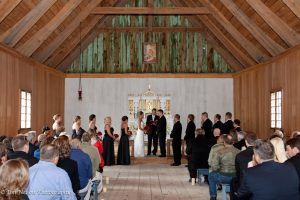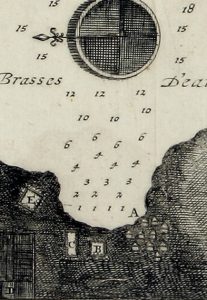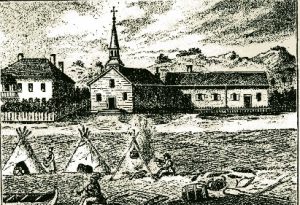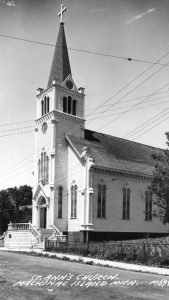

After the question is popped, the real fun begins- planning the wedding. One of the most exciting and challenging tasks is finding the perfect location for the memorable day. Outdoor or indoor venue? Intimate or spacious? In a busy city or tucked away on a quiet beach? The options are endless. Mackinac State Historic Parks offers ten historic wedding venues on Mackinac Island and in Mackinaw City. One of our truly unique historic wedding venues is the Ste. Anne de Michilimackinac church. Located in Colonial Michilimakinac, this reconstruction was built on the original location of the 18th-century church.
This beautiful setting also has a rich and fascinating history. As nations came and left, and soldiers marched in and out, there has always


been the existence of Roman Catholicism in the Straits of Mackinac. Located within the crossroads of the Great Lakes, Mackinac was a logical choice for missions. During the winter of 1670-71, Father Claude Dablon established the Mission of St. Ignace on Mackinac Island, named after St. Ignatius Loyola. That spring, Father Jacques Marquette replaced Dablon and the mission relocated from the island to present day St. Ignace. The Mission of St. Ignace flourished on the north side of the Straits until 1703 when the French established Fort Detroit and lured many of its followers away from the Straits area. The French Jesuits would finally close the St. Ignace missionary chapel in 1705 and try again on the south side of the Straits, in present day Mackinaw City. In 1716, Fort Michilimackinac was built right next to the new missionary chapel. This new parish was dedicated to Ste. Anne. With a growing parish, the French expanded Fort Michilimackinac in the 1730s to incorporate the church within the walls and construct a larger building.
Due to the defeat of the French in the French and Indian War, Fort Michilimackinac was controlled by the British. Roman Catholicism was allowed in British Canada and St. Anne’s remained within Michilimackinac. The British decided to move Fort Michilimackinac from its exposed location on the southern mainland to the hillside of Mackinac Island in 1779. With many residents of Michilimackinac hesitant to relocate, Commandant Patrick Sinclair wanted Ste. Anne’s Church to be one of the first


structures to be moved to the island. The church was rebuilt on the island and would become a vital part of the new village located below Fort Mackinac. With the help of Magdelaine Laframboise, a prominent Mackinac Island resident, a new building was built at its present day location in the 1820s. That building was replaced in 1873 by the current building. Ste. Anne’s Church has always been an important part of Mackinac Island’s community and continues to add baptisms, weddings, and funerals to its long-recorded history.
Today, guests can visit Colonial Michilimackinac and learn more about the fascinating history of the original Ste. Anne’s Church. Historians have learned more about the historical significance of this site through the weddings, baptisms, and funerals recorded in the church’s register. It is one of the earliest records of life in the Great Lakes region. This church invites guest to travel back in time and experience the beauty of the Mackinac Straits. When couples choose any of Mackinac State Historic Parks’ wedding venues, they get to be a part of history.


Source:
Brisson, Steven. “Witness to Five Centuries: The History of Ste. Anne’s Parish,” in Archibald. Northern Border, pp. 46-67.








